|
STATES |
DETAILS/RESULTS/ACTIONS |
|
A1: FUSE CHECK F23 |
|
|
1 Enter the OFF position. |
|
|
2 CHECK Fuse F23 (BJB). |
|
|
• Is the fuse good? |
|
|
→ Yes |
|
|
Go to A2 |
|
|
→ No |
|
|
REPLACE fuse F23 (20 A). CHECK the system is working properly. If the fuse blows again, LOCATE and REPAIR the short to ground using the wiring diagrams. |
|
|
A2: CHECK THE VOLTAGE IN THE FUSE F23 |
|
|
1 Connect Fuse F23 (BJB). |
|
|
2 Measure voltage between fuse F23 (20 A) and "mass". |
|
|
• Is battery voltage being recorded? |
|
|
→ Yes |
|
|
Go to A3 |
|
|
→ No |
|
|
RESTORE power to fuse F23 using the wiring diagrams. CHECK the system is working properly. |
|
|
A3: FUSE CHECK F28 |
|
|
1 CHECK Fuse F28 (BJB). |
|
|
• Is the fuse good? |
|
|
→ Yes |
|
|
Go to A4 |
|
|
→ No |
|
|
REPLACE fuse F28 (10 A). CHECK the system is working properly. If the fuse blows again, LOCATE and REPAIR the short to ground using the wiring diagrams. |
|
|
A4: FUSE VOLTAGE CHECK F28 |
|
|
1 Connect Fuse F28 (BJB). |
|
|
2 Drive the ON position. |
|
|
3 Measure voltage between fuse F28 (10 A) and "mass". |
|
|
• Is battery voltage being recorded? |
|
|
→ Yes |
|
|
Go to A5 |
|
|
→ No |
|
|
RESTORE power to fuse F28 using the wiring diagrams. CHECK the system is working properly. |
|
|
A5: VOLTAGE CHECK IN AUXILIARY HEATER |
|
|
1 Enter the OFF position. |
|
|
2 Disconnect the C878 auxiliary heater. |
|
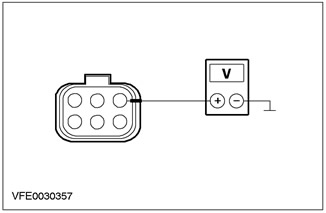
|
3 Measure the voltage between connector C878, pin 1, auxiliary heater circuit 30-RD18 (red), from the wiring harness side, and ground. |
|
• Is battery voltage being recorded? |
|
|
→ Yes |
|
|
Go to A6 |
|
|
→ No |
|
|
LOCATE and REPAIR the open circuit between the auxiliary heater and fuse F23 using the wiring diagrams. CHECK the system is working properly. |
|
|
A6: AUXILIARY HEATER VOLTAGE CHECK |
|
|
1 Drive the ON position. |
|
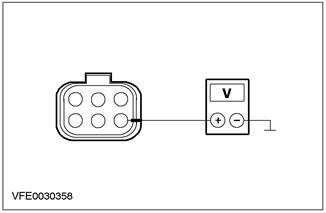
|
2 Measure the voltage between pin 4 of auxiliary heater connector C878, circuit 15-RD18 (green-red), from the wiring harness side, and ground. |
|
• Is battery voltage being recorded? |
|
|
→ Yes |
|
|
Go to A7 |
|
|
→ No |
|
|
LOCATE and REPAIR the open circuit between the auxiliary heater and S117 solder joint using the wiring diagrams. CHECK the system is working properly. |
|
|
A7: CHECK THE CONTROL VOLTAGE IN THE AUXILIARY HEATER |
|
|
NOTE: Use appropriate methods to cool down the outside temperature sensor to at least 5°C. |
|
|
1 Drive the START position. |
|
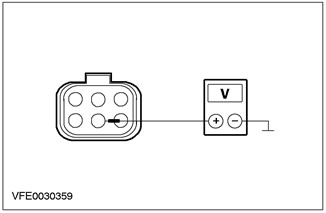
|
2 Measure the voltage between pin 5 of auxiliary heater connector C878, circuit 64S-RD18 (white-blue), from the wiring harness side, and ground. |
|
• Is battery voltage being recorded? |
|
|
→ Yes |
|
|
Go to A8 |
|
|
→ No |
|
|
Go to A9 |
|
|
A8: AUXILIARY HEATER GROUND CIRCUIT CHECK |
|
|
1 Enter the OFF position. |
|
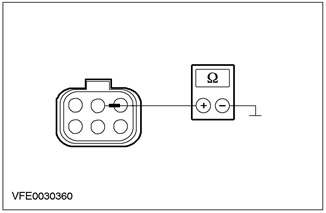
|
2 Measure the resistance between pin 2 of auxiliary heater connector C878, circuit 31-RD18 (black), from the wiring harness side, and ground. |
|
• Is the resistance less than 2 ohms? |
|
|
→ Yes |
|
|
CHECK and if necessary REPLACE the auxiliary heater. CHECK the system is working properly. |
|
|
→ No |
|
|
LOCATE and REPAIR the open circuit between the auxiliary heater and ground point G37 using the wiring diagrams. CHECK the system is working properly. |
|
|
A9: OUTDOOR TEMPERATURE SENSOR VOLTAGE CHECK |
|
|
1 Enter the OFF position. |
|
|
2 Disconnect the C875 outside temperature sensor. |
|
|
3 Drive the START position. |
|
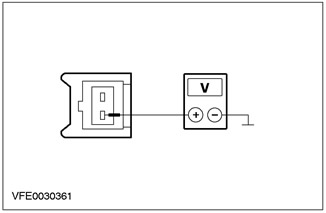
|
4 Measure the voltage between pin 1 of connector C875, outdoor temperature sensor, circuit 64-RD18 (white-blue), from the wiring harness side, and ground. |
|
• Is battery voltage being recorded? |
|
|
→ Yes |
|
|
Go to A10 |
|
|
→ No |
|
|
Go to A11 |
|
|
A10: CHECK THE ELECTRICAL CIRCUIT BETWEEN THE OUTSIDE TEMPERATURE SENSOR AND THE AMPLIFIER HEATER FOR AN OPEN |
|
|
1 Enter the OFF position. |
|
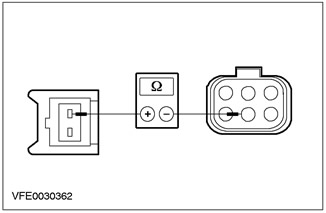
|
2 Measure the resistance between pin 2 of connector C875, outdoor temperature sensor, circuit 64S-RD18 (white-blue), on the wiring harness side, and pin 5 of auxiliary heater connector 878, circuit 64S-RD18 (white-blue), from the wiring harness side. |
|
• Is the resistance less than 2 ohms? |
|
|
→ Yes |
|
|
REPLACE the outside temperature sensor. CHECK the system is working properly. |
|
|
→ No |
|
|
LOCATE and REPAIR open circuit 64S-RD18 (white-blue) between the outside temperature sensor and the booster heater using the wiring diagrams. CHECK the system is working properly. |
|
|
A11: VOLTAGE CHECK IN ENGINE RUN RELAY |
|
|
1 Enter the OFF position. |
|
|
2 Disconnect C1013 Engine Run Relay (BJB). |
|
|
3 Drive the ON position. |
|
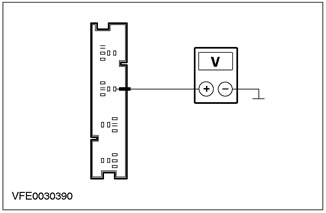
|
4 Measure the voltage between pin 3 of connector C1013, engine run relay circuit 15-PA20 (green-orange), from the wiring harness side, and ground. |
|
• Is battery voltage being recorded? |
|
|
→ Yes |
|
|
Go to A12 |
|
|
→ No |
|
|
LOCATE and REPAIR open circuit 15-PA20 (green-orange) between the engine run relay and fuse F28, using the wiring diagrams. CHECK the system is working properly. |
|
|
A12: CHECK THE CONTROL VOLTAGE IN THE ENGINE RUN RELAY |
|
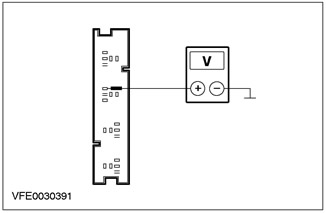
|
1 Measure the voltage between pin 1 of connector C1013 engine run relay circuit 15-PA19 (black and green), from the wiring harness side, and ground. |
|
• Is battery voltage being recorded? |
|
|
→ Yes |
|
|
Go to A13 |
|
|
→ No |
|
|
LOCATE and REPAIR the open circuit between the engine run relay and solder joint S117 using the wiring diagrams. CHECK the system is working properly. |
|
|
A13: CHECK ENGINE RUN RELAY GROUND ELECTRICAL CIRCUIT |
|
|
CAUTION: A test lamp rated at 12V and rated at 1.2W must be used when performing the following test. Otherwise, the PCM may be damaged or the test will give incorrect results. |
|
|
NOTE: Make sure the generator is working properly before taking the next measurement. |
|
|
1 Drive the START position. |
|
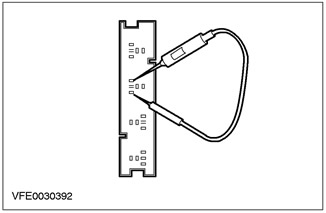
|
2 Use a test lamp to check the voltage between pins 1 and 2 of connector C1013 of the engine run relay (12 V, 1.2 W). |
|
• Is the indicator lamp on? |
|
|
→ Yes |
|
|
Go to A14 |
|
|
→ No |
|
|
Vehicles with 104-pin EEC: Go to A15 |
|
|
Vehicles with 121-pin EEC: Go to A16 |
|
|
A14: CHECK THE ELECTRICAL CIRCUIT BETWEEN ENGINE RUN RELAY AND OUTSIDE TEMPERATURE SENSOR FOR OPEN |
|
|
1 Enter the OFF position. |
|
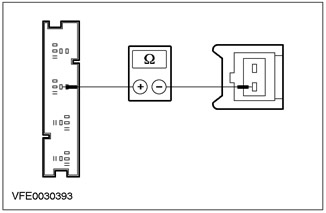
|
2 Measure the resistance between pin 1 of connector C1013 engine run relay circuit 64-PA20 (yellow-blue), on the wiring harness side, and pin 1 C875 of the outdoor temperature sensor connector, circuit 64-RD18 (white-blue), from the wiring harness side. |
|
• Is the resistance less than 2 ohms? |
|
|
→ Yes |
|
|
REPLACE engine run relay. CHECK the system is working properly. |
|
|
→ No |
|
|
LOCATE and REPAIR the open circuit between the engine run relay and the outside temperature sensor using the wiring diagrams. CHECK the system is working properly. |
|
|
A15: CHECK THE ELECTRICAL CIRCUIT BETWEEN THE ENGINE RUN RELAY AND THE POWER PACK CONTROL MODULE (PCM) FOR A BREAK |
|
|
1 Enter the OFF position. |
|
|
2 Disconnect the C415 PCM. |
|
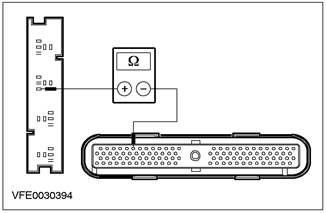
|
3 Measure the resistance between C1013 Engine Run Relay Pin 2, harness side, and C415 PCM Pin 6, circuit 31S-PA19 (black and green), from the wiring harness side. |
|
• Is the resistance less than 2 ohms? |
|
|
→ Yes |
|
|
CHECK and REPLACE PCM if necessary. CHECK the system is working properly. |
|
|
→ No |
|
|
LOCATE and REPAIR the open circuit between the engine run relay and the PCM using the wiring diagrams. CHECK the system is working properly. |
|
|
A16: CHECK THE ELECTRICAL CIRCUIT BETWEEN THE ENGINE RUN RELAY AND THE POWER PACK CONTROL MODULE (PCM) FOR A BREAK |
|
|
1 Enter the OFF position. |
|
|
2 Disconnect the C414 PCM. |
|
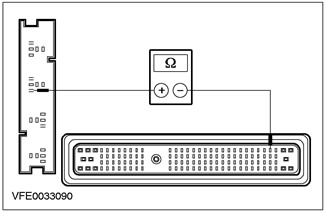
|
3 Measure the resistance between C1013 engine run relay connector pin 2, harness side, and C414 PCM connector pin 23, circuit 31S-PA19 (black and green), from the wiring harness side. |
|
• Is the resistance less than 2 ohms? |
|
|
→ Yes |
|
|
CHECK and REPLACE PCM if necessary. CHECK the system is working properly. |
|
|
→ No |
|
|
LOCATE and REPAIR the open circuit between the engine run relay and the PCM using the wiring diagrams. CHECK the system is working properly. |
|
Visitor comments